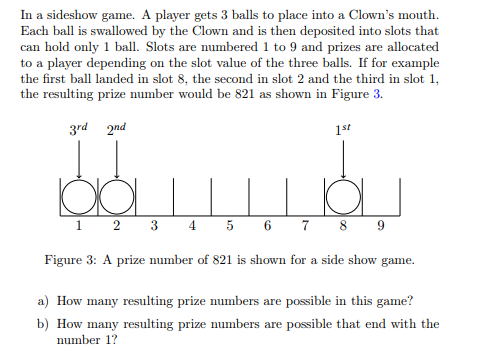In a sideshow game. A player gets 3 balls to place into a Clown's mouth. Each ball is swallowed by the Clown and is then deposited into slots that can hold only 1 ball. Slots are numbered 1 to 9 and prizes are allocated to a player depending on the slot value of the three balls. If for example the first ball landed in slot 8, the second in slot 2 and the third in slot 1, the resulting prize number would be 821 as shown in Figure 3. 3rd 2nd DOL 1 2 3 4 5 6 6 1st JOL 7 7 8 9 Figure 3: A prize number of 821 is shown for a side show game. a) How many resulting prize numbers are possible in this game? b) How many resulting prize numbers are possible that end with the number 1?
In a sideshow game. A player gets 3 balls to place into a Clown's mouth. Each ball is swallowed by the Clown and is then deposited into slots that can hold only 1 ball. Slots are numbered 1 to 9 and prizes are allocated to a player depending on the slot value of the three balls. If for example the first ball landed in slot 8, the second in slot 2 and the third in slot 1, the resulting prize number would be 821 as shown in Figure 3. 3rd 2nd DOL 1 2 3 4 5 6 6 1st JOL 7 7 8 9 Figure 3: A prize number of 821 is shown for a side show game. a) How many resulting prize numbers are possible in this game? b) How many resulting prize numbers are possible that end with the number 1?
Principles of Microeconomics
7th Edition
ISBN:9781305156050
Author:N. Gregory Mankiw
Publisher:N. Gregory Mankiw
Chapter22: Frontiers Of Microeconomics
Section: Chapter Questions
Problem 6PA
Related questions
Question

Transcribed Image Text:In a sideshow game. A player gets 3 balls to place into a Clown's mouth.
Each ball is swallowed by the Clown and is then deposited into slots that
can hold only 1 ball. Slots are numbered 1 to 9 and prizes are allocated
to a player depending on the slot value of the three balls. If for example
the first ball landed in slot 8, the second in slot 2 and the third in slot 1,
the resulting prize number would be 821 as shown in Figure 3.
3rd 2nd
1st
dol
1 2 3 4 5 6 7 8 9
Figure 3: A prize number of 821 is shown for a side show game.
a) How many resulting prize numbers are possible in this game?
b) How many resulting prize numbers are possible that end with the
number 1?
Expert Solution
This question has been solved!
Explore an expertly crafted, step-by-step solution for a thorough understanding of key concepts.
Step by step
Solved in 3 steps

Follow-up Questions
Read through expert solutions to related follow-up questions below.
Follow-up Question

Transcribed Image Text:b) How many resulting prize numbers are possible that end with the
number 1?
c) How many resulting prize numbers are possible that end with an
odd number?
Solution
Knowledge Booster
Learn more about
Need a deep-dive on the concept behind this application? Look no further. Learn more about this topic, economics and related others by exploring similar questions and additional content below.Recommended textbooks for you

Principles of Microeconomics
Economics
ISBN:
9781305156050
Author:
N. Gregory Mankiw
Publisher:
Cengage Learning


Principles of Economics (MindTap Course List)
Economics
ISBN:
9781305585126
Author:
N. Gregory Mankiw
Publisher:
Cengage Learning

Principles of Microeconomics
Economics
ISBN:
9781305156050
Author:
N. Gregory Mankiw
Publisher:
Cengage Learning


Principles of Economics (MindTap Course List)
Economics
ISBN:
9781305585126
Author:
N. Gregory Mankiw
Publisher:
Cengage Learning

Principles of Economics, 7th Edition (MindTap Cou…
Economics
ISBN:
9781285165875
Author:
N. Gregory Mankiw
Publisher:
Cengage Learning

Principles of Microeconomics (MindTap Course List)
Economics
ISBN:
9781305971493
Author:
N. Gregory Mankiw
Publisher:
Cengage Learning

Managerial Economics: Applications, Strategies an…
Economics
ISBN:
9781305506381
Author:
James R. McGuigan, R. Charles Moyer, Frederick H.deB. Harris
Publisher:
Cengage Learning